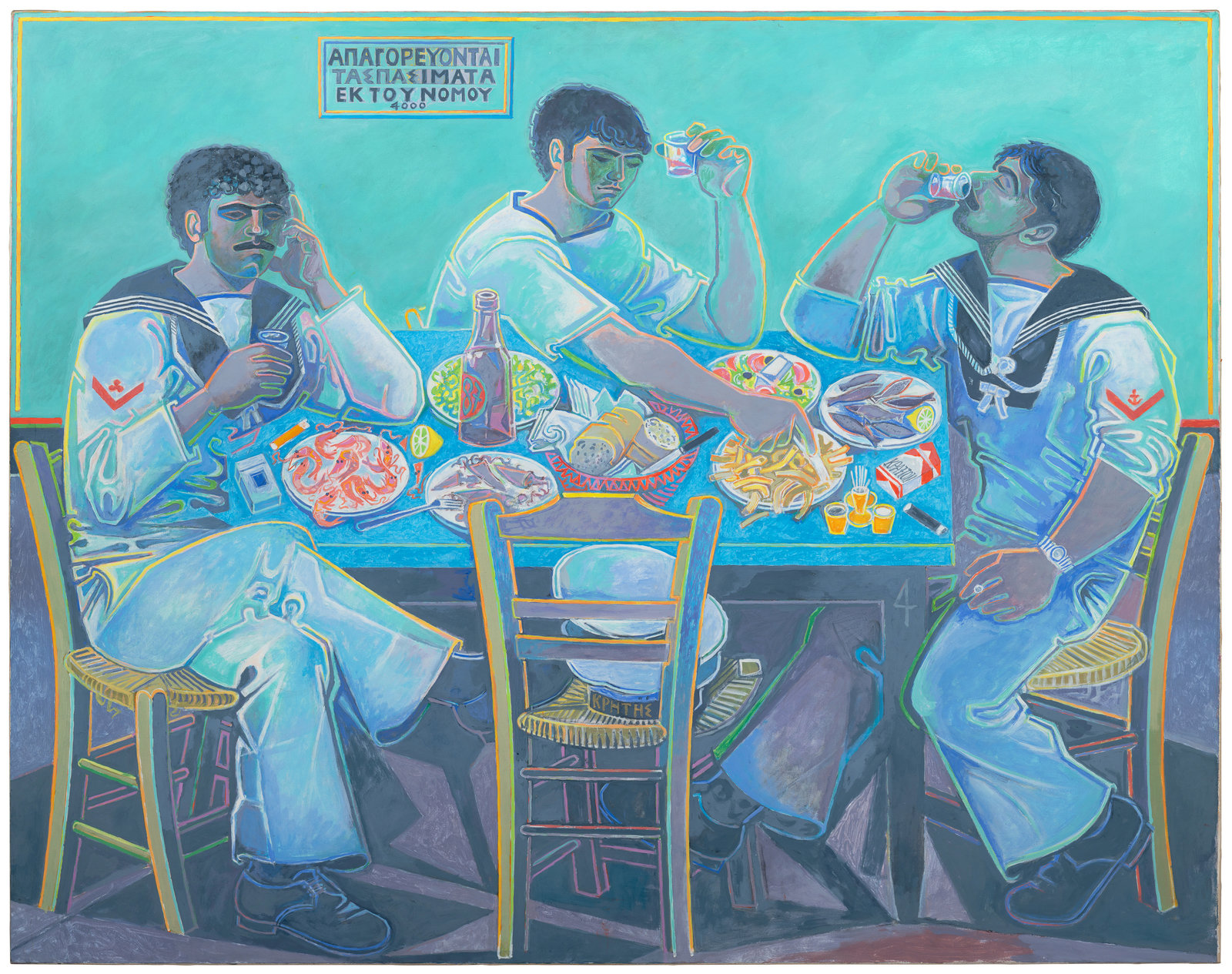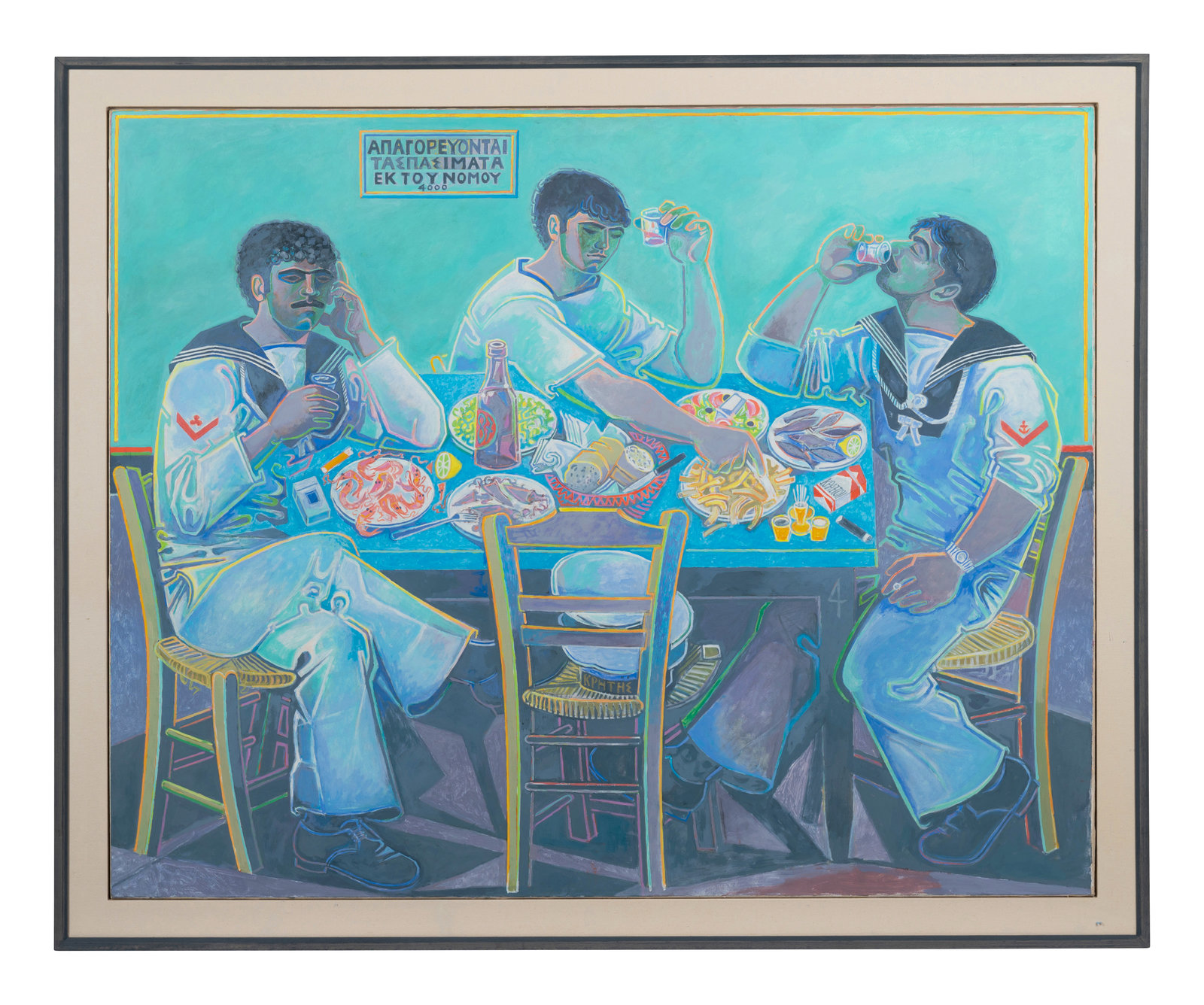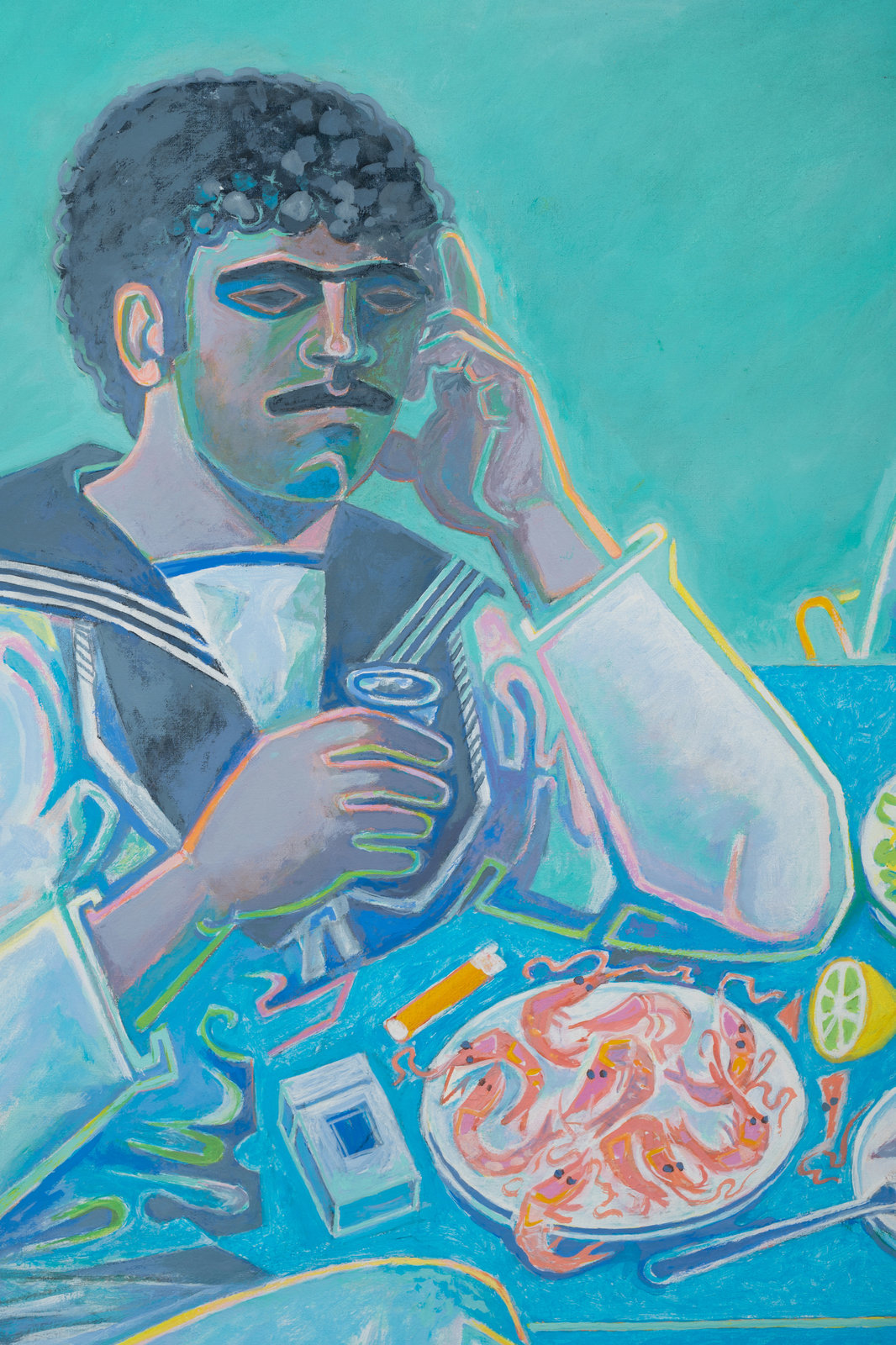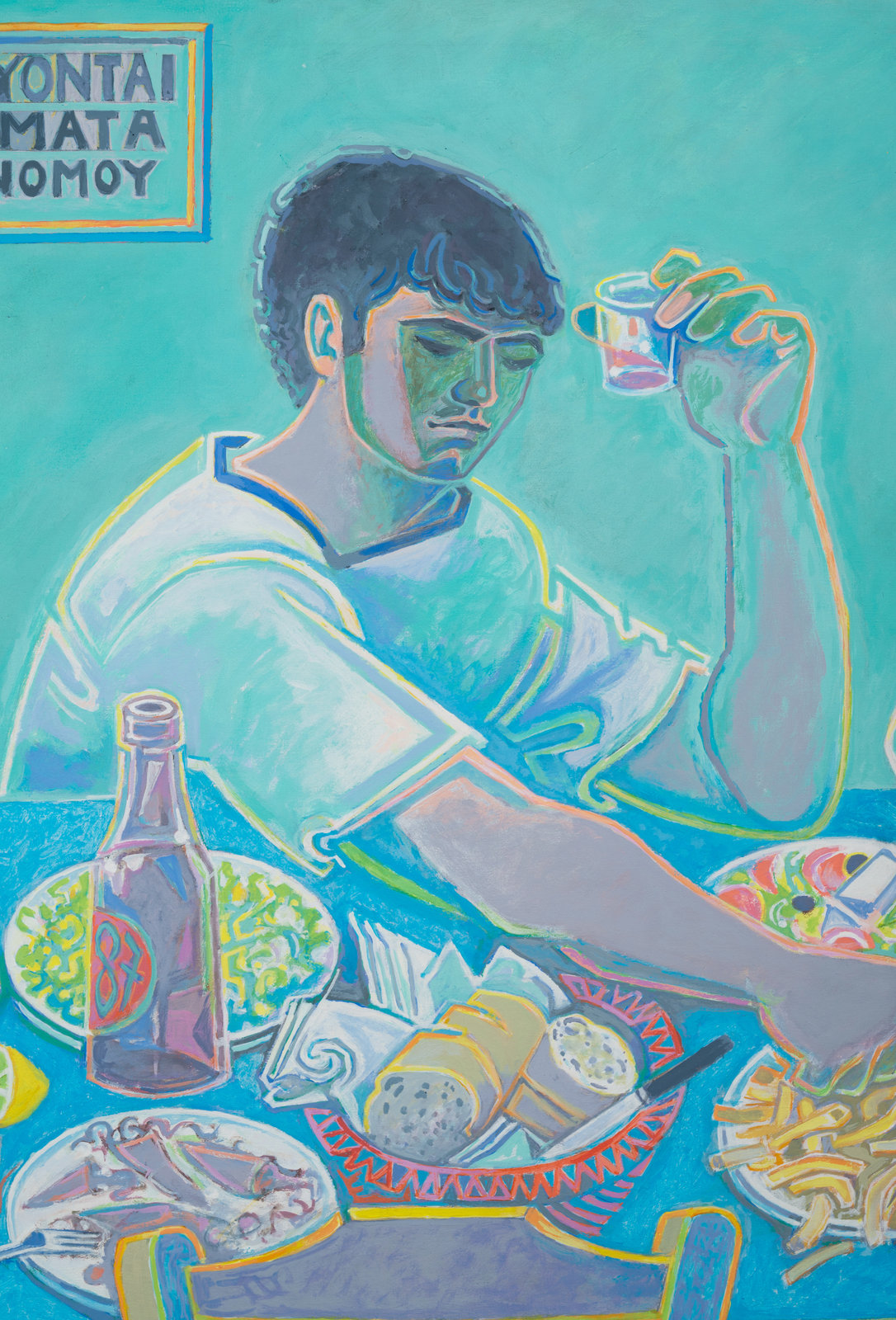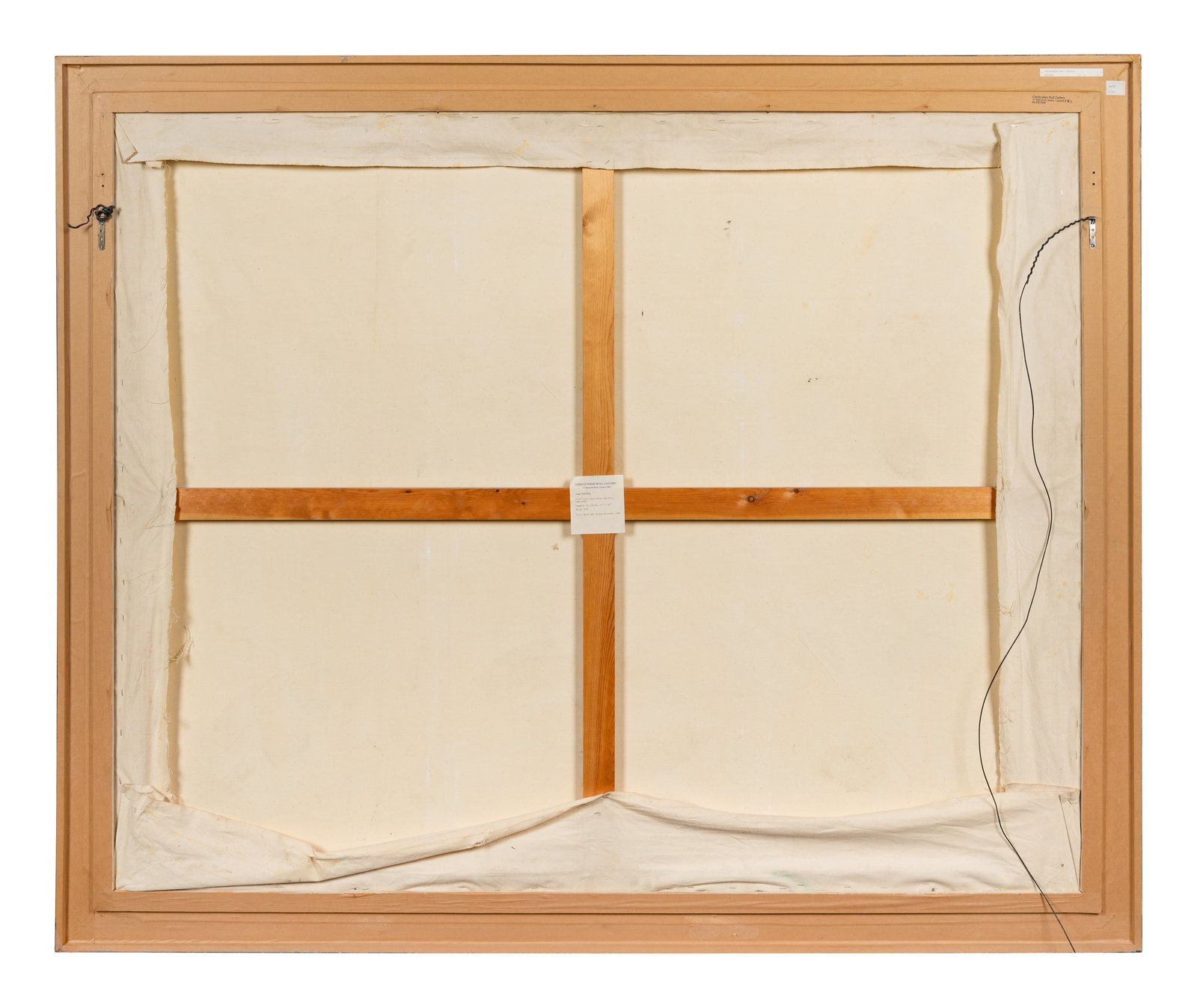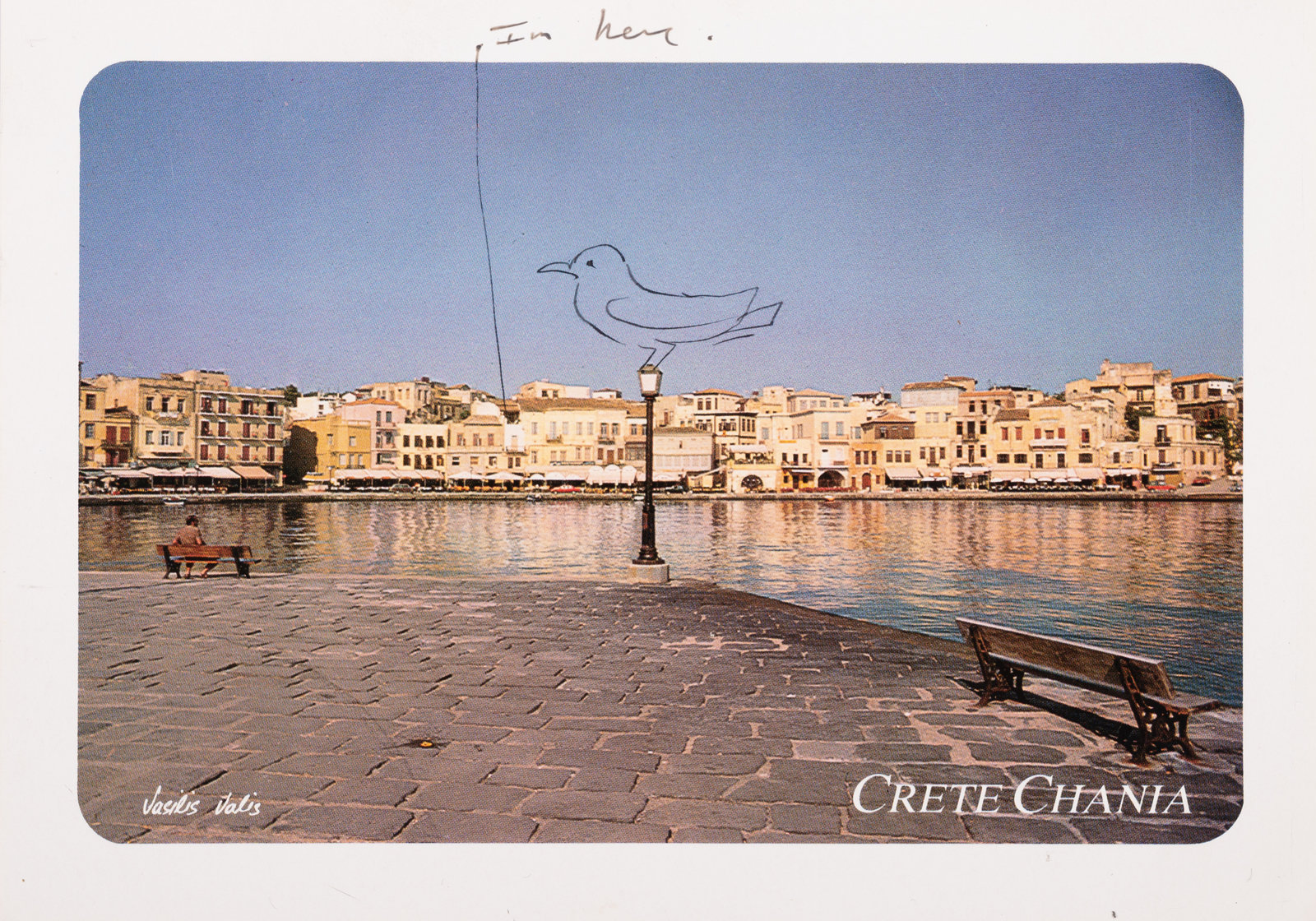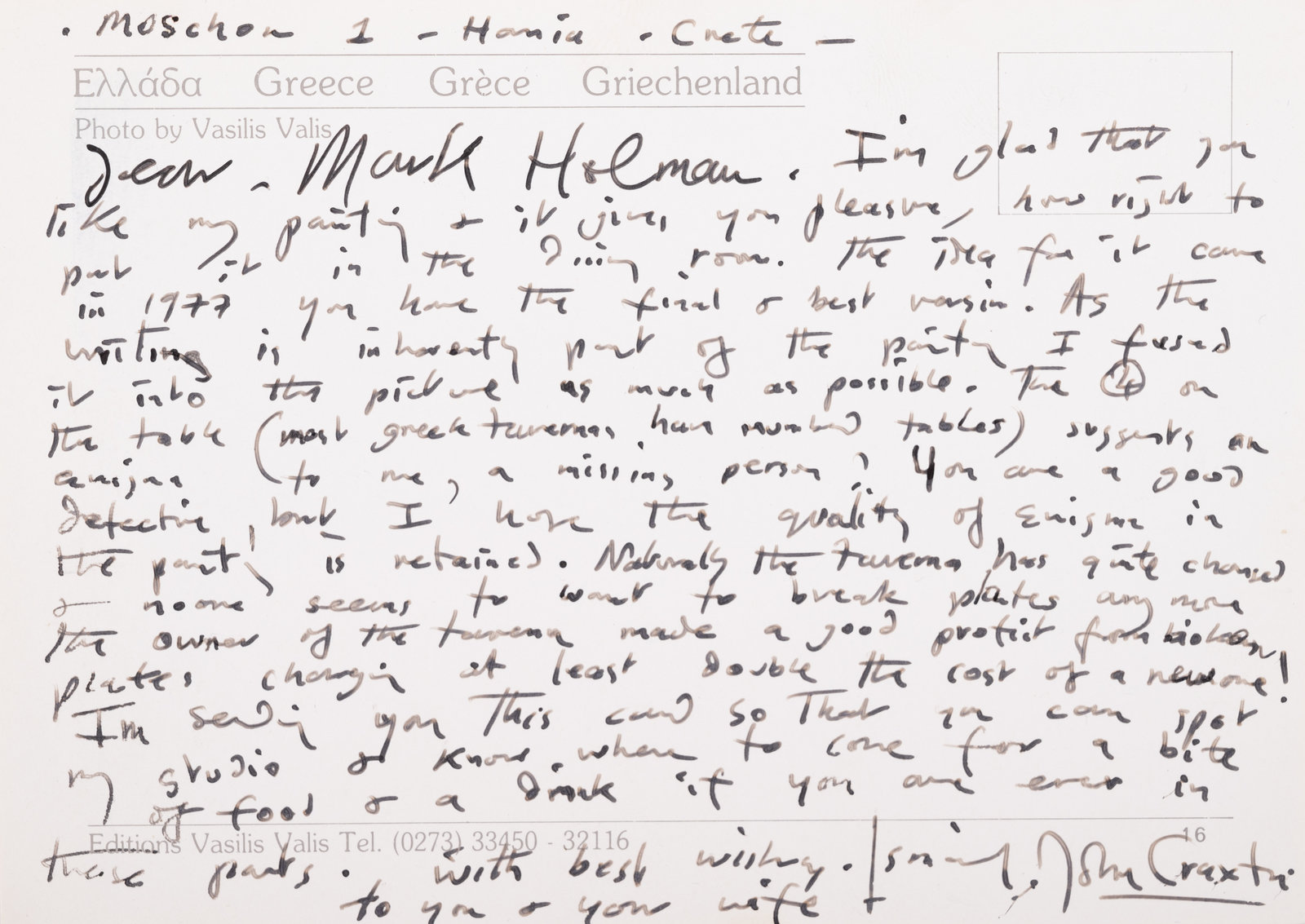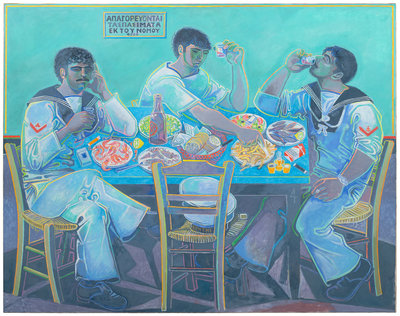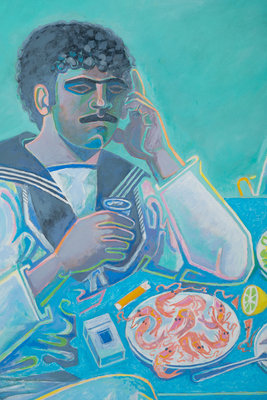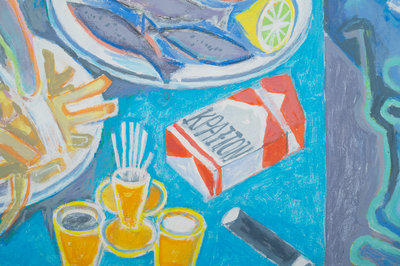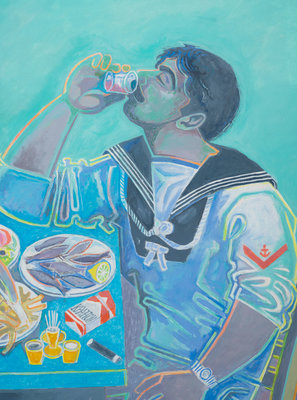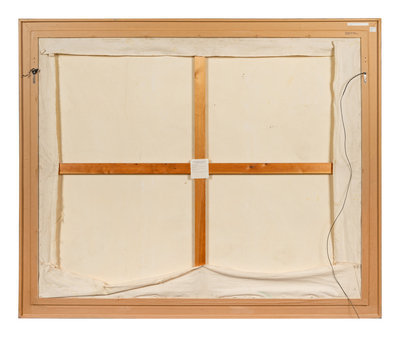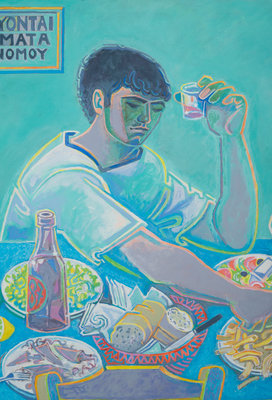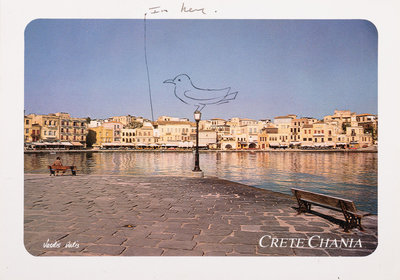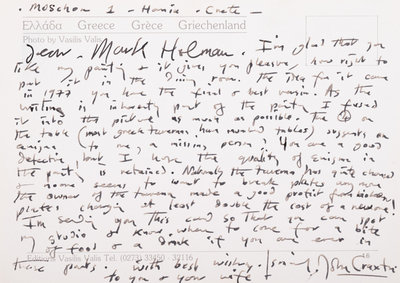John Craxton
(British, 1922-2009)
Still Life with Three Sailors, 1982-1987
Sale 1027 - Post War & Contemporary Art
May 11, 2022
10:00AM CT
Live / Chicago
Estimate
$150,000 -
$250,000
Sold for $400,000
Sold prices are inclusive of Buyer’s Premium
Lot Description
John Craxton
(British, 1922-2009)
Still Life with Three Sailors, 1982-1987
tempera on canvas
signed in Greek and dated
50 x 63 inches.
Property from the Carmen S. Holeman Trust, Indianapolis, Indiana
Included with this lot is a letter about the painting from the artist to Mr. Mark Holeman.
Provenance:
Christopher Hull Gallery, London
Acquired from the above by Mr. and Mrs. Mark Holeman in 1987
Literature:
Ian Collins, John Craxton, Farnham, UK: Lund Humphries, 2011, 152.
Lot Essay:
John Craxton and the Pursuit of Arcadia
Provenance:
Christopher Hull Gallery, London
Acquired from the above by Mr. and Mrs. Mark Holeman in 1987
Literature:
Ian Collins, John Craxton, Farnham, UK: Lund Humphries, 2011, 152.
Lot Essay:
John Craxton and the Pursuit of Arcadia
The charisma of British artist John Craxton (1922-2009), along with his dislike of art historical interpretation of his own work, has unfortunately allowed for a certain undervaluation of his artwork, in favor of stories about his personal antics. This has been especially true of his late career works, often characterized as overly sunny, cheerful, and non-critical: the output of a man enjoying his leisurely life in Crete, as he had for many years.[i] In this centenary year of Craxton’s birth, it is important to revisit these claims, as scholars contend with his legacy in a year-long series of exhibitions, currently underway at the Benaki Museum (Athens). This charge of artistic flippancy belies such works as Still Life with Three Sailors (1987), a late masterpiece, which, through a complex composition defined by color and line indebted to the Greek art historical tradition and full of visual and verbal puns, makes a strong statement about arcadia denied.
Craxton, born to a London bohemian family deeply involved in arts and music, moved to Greece first in 1947, spending much of his life in Chania on Crete and returning yearly in 1977, after leaving when the junta dictatorship took over in the mid-1960s.[ii] From the 1940s and on, Craxton became known for his bright Mediterranean palette and themes and his own adoption of village life.[iii] Still Life with Three Sailors is heavily influenced by time spent holding court in tavernas, as three men with dark, curly hair sit down to drink around a table laden with food. Craxton developed this composition for over eight years before completing the first version of this painting ((Still Life with Three Sailors (1980-1985), Private Collection)), and the presently offered second larger version finished two years later.[iv] Craxton—in a letter included with this lot—referred to this painting as the “final + best version.” Christopher Hull represented both versions; Hull was so impressed with Craxton’s work that he flew to Crete in 1981, arriving at Craxton’s door with bribes of whiskey and cigars to woe the artist to his roster.[v] The first version was a centerpiece of the Craxton British Museum exhibition in 2018, discussed by both scholar Ian Collins and Patrick “Paddy” Leigh Fermor, poet and Craxton’s long-time friend in Greece.
The scene arranges three men in a row. The two on the ends wear sailor suits, flapped collars included, while the center man, without naval uniform, probes a plate of French fries. The structure owes much to the Byzantine Holy Trinity icon where three angels, Old Testament guests of Abraham and Sarah, are depicted, sitting down to a meal around a small table in a similar composition.[vi]
Craxton highly revered Byzantine art and his interest in its aesthetic directly informed his practice.[vii] Craxton particularly admired and drew influence from the limited palette and flattened perspectives of this style, favoring shallow spaces that open up to the viewer as opposed to the Western-point perspective that draws in the viewer.[viii] Connecting icons to the Cubists—another inspiration—, he said, “The good ones inverted perspective—exactly what the Cubists thought they’d invented.”[ix] As in the Holy Trinity icon, three men are arranged in an oval composition. The knees of the two flanking men face each other. The naval hats precariously balanced on a chair in the lower center complete the oval. The table’s plane tilts down, impossibly but elegantly, so the viewer may see the entirety of its surface. In contrast to the icon where the three angels look at and acknowledge each other, Craxton’s sailors glaringly isolate themselves from their tablemates, at once apart and a part of the shared meal.
Craxton—a lover of good food and conversation— said that “The most beautiful sound in the world is of other people talking over a meal.”[x] So conspicuous then is the absence of interaction among the sailors. The leftmost sailor uses his left hand to prop himself up but also to barricade himself from his companions, staring off into an unknown distance. The center man looks only at his next bite, presenting a shielding shoulder to the man on the left, his left hand holding a wine glass buffer against the man at his right. The rightmost sailor drinks with his eyes completely closed, alone in thought or overindulgence. Craxton’s Chania home was close to the Souda Bay naval base, and Craxton had many relationships with sailors. Leigh Fermor was reminded when looking at this painting’s first version of these sailors “not knowing where to go, not at all happy at being in Crete, and sad and homesick for their islands and harbours. The look will vanish after a few drinks…”[xi] Wistfulness surrounds these men, trapped in this taverna. Craxton’s use of line and color emphasizes this feeling, creating division and heightening flatness, artificiality, and the sense of interiority.
Bright contour lines unify the scene, outlining forms in greens, yellows, and orange, a stark contrast to the predominantly blue palette, as though defined by Byzantine mosaic tesserae. This is one of the biggest differences with the prior composition of Still Life with Three Sailors and this painting. While the first includes these distinguishing contours, they are in more muted shades and the sailors’ clothes are in whiter tones, with more background shades of magenta, yellow, and green. However, this painting’s color scheme favors blues, teals, and dark purples—except the meal components, popping on the table as tempting bright green, fuchsia, and yellow— while the contours glow like neon, both heightening the overall compositional balance while also emphasizing the figures’ individual division. These bold electrified lines heighten the theatrics, as the sailors are bathed in artificial taverna light. The lighting, emphasizing Craxton’s Cubist influence, is particularly complex, as unseen light sources individually spotlight each sailor, leading to the especially impressive shadows fracturing beneath the table. Additionally, a yellow line defines the space along the painting’s top edges, further separating the table vignette from other potential patrons, while the solid teal background likewise limits the depth, keeping the plane intentionally shallow.
Craxton was renowned for his love of visual and verbal puns, which abound in his work.[xii] The date and his signature are cleverly hidden here for the viewer to discover—an 87 snaking around the wine bottle and KPAΞTON—the artist’s name in Greek—the branding on a cigarettes package. As early as 1943, he used cuttlefish and squid as emblematic puns on his name— kraken to Craxton—and a plate of calamari is found at the table’s center.[xiii]
As in Byzantine art, where lettering—often in all caps— identifies the scene, here too does the bar sign enlighten, reading: BREAKING [PLATES] IS NOT ALLOWED PER LAW 4000. Law 4000 (1958), abolished as late as 1983—during the compositional construction of this painting—, was an attempt to limit general hooliganism amid the growing Greek youth culture influenced by international punk groups, like the Teddy Boys in England.[xiv] It outlawed petty crime and disruption, especially the common act of yogurt throwing (yaourtoma), where disliked authority figures were pelted in the face with plastic yogurt cups—a still-popular, particularly Greek, form of protest.[xv]
During the latter stages of his life, Craxton bemoaned Greek commercialization and globalization where, according to Collins, “Wildness was being tamed and tradition blitzed,” causing an increased note of melancholy in his works beginning the mid-1970s.[xvi] Here, through this mature masterpiece echoing Greek tradition, Craxton shows its inversion. Rather than the Greece Craxton loved, an arcadia of Mediterranean sun—a simple, traditional life of community, close to nature—, the sailors, though still beautifully bathed in Greek blues, surrounded by local food and wine, are stuck inside this interior neon artificial space, neither talking nor laughing and kept from throwing plates. Craxton suggests it would be more fun if they would.
Bibliography
Collins, Ian. “Chania: View of the Harbour.” In Ghika, Craxton, Leigh Fermor: Charmed Lives in Greece, 3rd Revised Edition, edited by Evita Arapoglou, 113-142. Nicosia, Cyprus: A.G. Leventis Gallery, 2018.
Collins, Ian. John Craxton. Farnham, UK: Lund Humphries, 2011.
Collins, Ian. “The Later Years: John Craxton.” In Ghika, Craxton, Leigh Fermor: Charmed Lives in Greece, 3rd Revised Edition, edited by Evita Arapoglou, 179-186. Nicosia, Cyprus: A.G. Leventis Gallery, 2018.
Eplett, Layla. “Culture of Resistance: Protesting Greece’s Politics with Yogurt.” Scientific American. September 16, 2013. https://blogs.scientificamerican.com/food-matters/culture-of-resistance-protesting-greecee28099s-politics-with-yogurt/.
“The ‘Holy Trinity’ Icon—The ‘Troitsa.’” Trinity Iconography Institute. Accessed March, 9, 2022.http://www.trinityiconographers.org/five-specific-icons/.
[i] Ian Collins, John Craxton (Farnham, UK: Lund Humphries, 2011), 65.
[ii] Ibid., 82; 143.
[iii] Stories of Craxton’s larger-than-life character in Crete abound. So complete was his embrace of life on Crete that the actress and former Greek Minister of Culture, Melina Mercouri, once hailed him as a native as he approached from a distance. He was known to speak Greek with a local dialect learned from the working class, full of swearing and slang. A maid at one of this friend’s homes once reported that a taxi-driver was calling after she answered the phone. He was known as a vital community leader often ensconced in conversation in local wine shops and tavernas, and, as he aged, sometimes hit people with a stick or his cane to emphasize a point. See: Ian Collins, “The Later Years: John Craxton,” in Ghika, Craxton, Leigh Fermor: Charmed Lives in Greece, 3rd Revised Edition, ed. Evita Arapoglou (Nicosia, Cyprus: A.G. Leventis Gallery, 2018), 179. and Collins, John Craxton, 76; 129.
[iv] Collins, John Craxton, 152
[v] Ian Collins, “The Later Years: John Craxton,” 184.
[vi] This iconographical depiction of the Holy Trinity was created by Andrei Rublev in 1411 and was standardized in 1551 as the accepted prototype of this Biblical scene. See: “The ‘Holy Trinity’ Icon—The ‘Troitsa’,” Trinity Iconography Institute, accessed March, 9, 2022, http://www.trinityiconographers.org/five-specific-icons/.
[vii] In the 1960s, he and photographer John Donat began a project to document all of Crete’s painted churches, fearing this cultural patrimony was in danger. On several occasions, the two even tried to clean the icons themselves, for which Craxton was briefly arrested in misunderstanding 1995 as a suspected vandal.
See: Collins, John Craxton, 127.
[viii] Ibid., 126.
[ix] Ibid.
[x] Ibid, 154.
[xi] Ian Collins, “Chania: View of the Harbour,” in Ghika, Craxton, Leigh Fermor: Charmed Lives in Greece, 3rd Revised Edition, edited by Evita Arapoglou (Nicosia, Cyprus: A.G. Leventis Gallery, 2018), 140.
[xii] Collins, John Craxton, 58.
[xiii] Ibid.
[xiv] Layla Eplett, “Culture of Resistance: Protesting Greece’s Politics with Yogurt,” Scientific American, September 16, 2013, https://blogs.scientificamerican.com/food-matters/culture-of-resistance-protesting-greecee28099s-politics-with-yogurt/.
[xv] Ibid.
[xvi] Collins, John Craxton, 172.
Condition Report
The physical condition of lots in our auctions can vary due to
age, normal wear and tear, previous damage, and
restoration/repair. All lots are sold "AS IS," in the condition
they are in at the time of the auction, and we and the seller make
no representation or warranty and assume no liability of any kind
as to a lot's condition. Any reference to condition in a catalogue
description or a condition report shall not amount to a full
accounting of condition. Condition reports prepared by Hindman
staff are provided as a convenience and may be requested from the
Department prior to bidding.
The absence of a posted condition report on the Hindman website or
in our catalogues should not be interpreted as commentary on an
item's condition. Prospective buyers are responsible for
inspecting a lot or sending their agent or conservator to inspect
the lot on their behalf, and for ensuring that they have
requested, received and understood any condition report provided
by Hindman.
Please email conditionreports@hindmanauctions.com for any additional information or questions you may have regarding this lot.
